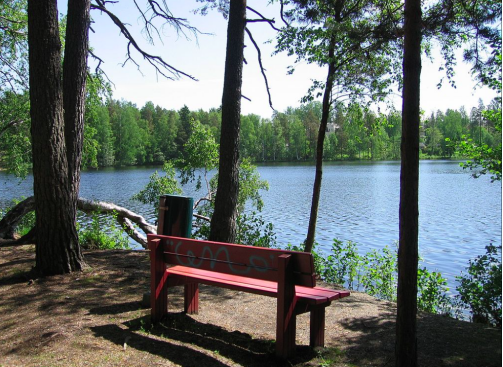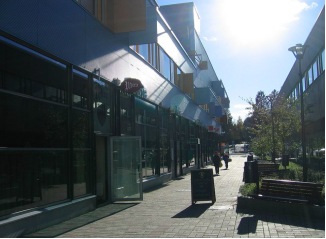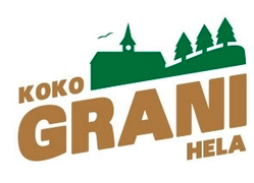Kauniainen 作者: 来源: 发布时间:2021-10-15
一、所属省或是州,具体位置,人口,面积
Kauniainen is a small town and a municipality of 9,559 inhabitants (31 January 2019) in the Helsinki Metropolitan Area, Finland. It is surrounded by the City of Espoo, in Greater Helsinki. Kauniainen was founded by a corporation in 1906, AB Grankulla, that parcelled land and created a suburb for villas; Kauniainen received the status of a market town in 1920, the Finnish name in 1949, and the title of kaupunki ("city, town") in 1972.
The municipal taxation rate in Kauniainen is the lowest in Finland (16.5%), which has made the city attractive to high-income families. This in turn makes the average income generally high, making it possible to keep the taxation rate low without compromising the service to the inhabitants. Approximately 58% of the population have Finnish as their mother tongue while 38% are Swedish speakers. The dominant party in the city council has traditionally been the Swedish People's Party.

二、自然地理
1.地理条件
There are three districts in Kauniainen called I, II and III. No districts are named because of the small size of the town. The only area that is viewed as a named district is Kasavuori (Swedish: Kasaberget) in the western part of the town.
At the end of 2017, Kauniainen had 9,624 inhabitants, of whom 9,484 lived in agglomerations, there were no inhabitants in sparsely populated areas and the coordinates of the place of residence of 140 inhabitants were not known. The degree of agglomeration is calculated for those residents whose coordinates of residence are known; The degree of agglomeration in Kauniainen is 100.0%. The population of the agglomeration of Kauniainen belongs to only one agglomeration. The agglomerations of Kauniainen do not form their own agglomeration, but are part of the central city of Helsinki, which, in addition to Kauniainen, extends to the territory of several Helsinki suburbs and had a population of 9,484 at the end of 2017. Helsinki city center has a total population of 1,268,296 and an area of 680.12 square kilometers.
2.交通情况
Kauniainen has good road connections in most directions. The east-to-west Helsinki–Turku motorway (national road 1) passes Kauniainen to the south and the old Helsinki–Turku main road passes the northern parts of the town. The construction of the motorway in the 1960s played a big role when new inhabitants moved to Kauniainen, when they could drive quickly along the motorway into Helsinki's city centre. The north-to-south Kehä II (Ring Road 2) passes the eastern corner of Kauniainen.
Kauniainen is served by two commuter rail stations, Kauniainen and Koivuhovi, on the Rantarata line, which was opened in 1903. The railway has been important for the development of Kauniainen as a suburb of Helsinki. Trains leave appromaximately every 15 minutes and the ride to Helsinki Central railway station takes about 20 minutes. There are two regional bus lines which connect to Helsinki. There are also local bus lines which connect to various districts of Espoo.
The internal roads leading to the center of Kauniainen are Kauniaistentie starting from Turunväylä, Helsingintie starting from Turuntie to Viherlaakso and Asematie-Bembölentie from the west and Kauppalantie from the south. The main means of public transport in Kauniainen is the train. The waterfront has played a very important role in the development of the city as a suburb of Helsinki. Trains run in the direction of Helsinki every 15 minutes symbols U and E. The west-facing U-Kirkkonummi train runs every half hour and the E train Kauklahti every half hour. In quiet times, the L-train runs. The journey to the center of Helsinki takes less than 20 minutes from Kauniainen Railway Station. In addition, in the western parts of the city, right next to the Espoo border, is the Koivuhovi railway station, which serves residents of the Kasavuori area, among other things. After the completion of the Espoo city line, train connections from Kauniainen will continue to improve, and travel time to the center of Helsinki will be reduced by several minutes.
From Kauniainen, regional line 212 runs from Kauniala via Kasavuori to Kamppi in Helsinki. Kauniainen also has internal bus lines and connection lines to the metro station in Espoo, such as lines 548 and 549 via Mankka to Tapiola and line 533 from Järvenperä to Matinkylä. Line 224 runs from the center of Espoo via Kauniainen and Karakallio to Leppävaara. On weekends, the night line 118N runs in the direction of Tapiola and Kamppi through Kauniaste. In addition, the northern parts of Kauniainen are served by Turuntie lines 226, 227, 235 and 238 to Leppävaara, 565 to Länsi-Vantaa and 235 to the center of Espoo, and via Pitäjänmäki and Mannerheimintie to Elielinaukio.
三、经济发展和规模
Kauniainen and its neighbouring areas have lively small-business activity, which enhances the city’s supply of services. Kauniainen’s Union of Entrepreneurs, which is a membership association of the Federation of Finnish Enterprises, assists entrepreneurs in various issues concerning entrepreneurship.Entrepreneurs maintain in cooperation with the city a branch register.
YritysEspoo (EnterpriseEspoo) provides advice for both new and established businesses in Kauniainen, Espoo and Kirkkonummi. For those who are considering starting a business, we offer advice in developing the business idea, operational planning and other practical matters. We also offer support and guidance to established businesses on issues such as business development, growth and internationalization. Our services are confidential and free of charge.
https://www.kauniainen.fi/en/the_city_and_public_decision-making/entrepreneurship
https://www.yrittajat.fi/paakaupunkiseudun-yrittajat/kauniaisten-yrittajat-ry
https://www.yritysespoo.fi
四、产业特点/重点项目
The center of Kauniainen was renovated in the 1960s with the construction of a new precast concrete center with shopping centers in line with the then ideal. At one time, a modern shopping mall has since been perceived as ugly and impractical. In 2000, the Grani shopping center designed by Kai Wartiainen was completed in the city center. However, the layout of the new shopping center with its bright colors has provoked conflicting reactions. The city has drawn up a new town plan for the city center. The new downtown plan has been implemented, with the exception of one key block in the downtown area, where the project has been at a standstill for years. The city has begun the process of redeeming the land owned by the construction company NCC.
In honor of the 100th anniversary of Kauniainen in 2007, a new sculpture called "Foni" created by Kimmo Schroderus was erected in front of the City Hall in the city center. Although Kauniainen is a prosperous city, investment in public areas has only begun in the 21st century. Graffiti and poorly coated coatings, for example, can still be seen. However, the situation has improved considerably, for example with road construction projects. The infrastructure has been improved, especially in and around the city center, for example with the renovation of Keskuskatu Tunnelitie in 2010.

The largest employers in Kauniainen are the City of Kauniainen, Kauniala War Injury Hospital, the Workers' Academy and the Finnish Bible School. Kauniainen is very self-sufficient in services, despite the small size of the city. The city has, among other things: Swimming Hall, Ice rink, Sledding slope,Two ball fields, one of which is heated,A ball hall dug into the rock, Athletics field,Finnish-language primary school Mäntymäki school, secondary school Kasavuori school and upper secondary school Kauniainen upper secondary school,Swedish-language primary school Granhultsskolan, secondary school Hagelstamska skolan and upper secondary school Gymnasiet Grankulla samskola,College of Music (operates in Villa Vallmogård)
Citizens' College (Petra), School of Fine Arts, Kauniainen Workers' Academy, HUMAK University of Applied Sciences, Kauniainen Campus, Finnish Bible School, Kauniala War Injury Hospital, Shopping center Grani, Kauniainen City Library, Health center, Cinema Bio Grani.
The city has recently considered several plans to put the Gallträsk lake into recreational use. Among other things, since 2006, the city has dredged the lake and transferred the pulp to nearby geotubes to remove excess water. The project has gained mainly positive experiences and will be continued. The resulting pulp will later be used, among other things, as a landfill, as the toxic concentrations have been found to be low enough for this use, at least for the time being. If the toxin levels were too high, the pulp would probably be transported to a landfill.
五、风景名胜,景点( attractions)
1. Kauniainen library

The City Library is situated in the city centre of Kauniainen, close to the railway. The building is recognisable by its white brick facade. We are one of the four HelMet libraries. This means that you can also use the services of the libraries in Espoo, Helsinki and Vantaa with our library card. Similarly, the customers of other HelMet libraries are welcome to use our services! We have operated in these current premises since 1986. However, library operations started in 1924 in Kauniainen. In 2005, the library was renovated in order to increase the feel of space and to provide new services.
The initiative to establish what is today Kauniainen City Library was taken in 1923. In the following year, a modest library was opened in the finance office of the borough (today, located at Thurmanin puistotie 1) where 25 m2 of floor space had been reserved for the library. At the end of the first year of operation, the library only owned 173 books. Luckily, the number of users was relatively high at 90. A suitable opportunity for expansion emerged as the library rented part of Helsinki Savings Bank’s offices on the second floor at Thurmanin puistotie 8, in the heart of city centre. The library moved into these premises in 1967 and then had 350 m2 worth of space. In addition to the space needed for normal loaning functions, a reading room, a dedicated children's department and a so-called music corner were set up. The library premises were even used for art exhibitions, organised monthly by the city’s cultural board until 1979. Launched in 1974, home delivery of books was already a popular form of service at the time.
https://www.kauniainen.fi/en/culture_and_recreation/kauniainen_city_library/about_the_library/history
https://www.helmet.fi/en-US/Libraries_and_services/Kauniainen_library/Whats_going_on/Library_services_in_the_summer(211218)
2.Koko Hela Grani

It is a digital project for educational activities that implements the information management strategy approved by the City Council in June 2013. The basic idea of the project is that learning happens everywhere. Information and communication technology is a natural part of today's public environments, and the entire city serves as an experience environment for local residents as well as a learning environment for students. The aim of the project is to create good models, common guidelines and concrete improvements. The whole Hela Grani thus develops new creative activities that promote learning and a good life. Through the window above, you can explore Junghans on Round.me, in 360 images. If you have VR glasses, turn on VR mode in Round.me and place your smart device in the VR glasses.
https://www.kauniainen.fi/koulutus_ja_varhaiskasvatus/koko_hela_grani
3. Gallträsk
Gallträsk is a lake in Kauniainen. It covers an area of about 11.7 hectares and an average depth of about a meter. It is the only lake in the Kauniainen area as a whole. Water flows from the lake through the ditch that originates in the northeastern corner to Lake Lippajärvi in Espoo. At the western end of the lake is a small protected Träskmossen bog. Gallträsk has been the core of the Kauniainen villa area since the establishment of Grankulla (Kauniainen in Finnish) in 1906. It was quite a well-maintained lake at the time and a very popular swimming destination due to its shallow beaches and clean water.
Today, Gallträsk is in a much better state than it was three decades ago. Nitrogen and phosphorus concentrations in the lake have decreased significantly. Even in sediment, zinc no longer exceeds the permissible limit value for heavy metals. In addition to zinc, lead, mercury, cadmium and copper exceed the guideline values.
六、历史文化
1.历史
Around 10,000 years ago, after the Ice Age, only a few islets were visible in the Yoldia Sea, heights that today form the highest peaks of the area that is today known as Kauniainen. As the land slowly rose Kauniainen became a part of the inner archipelago around 4,000 years ago and there is evidence of human activity in the area in form of pieces of ceramics from this time period. However, the first permanent settlements in the area were established in the 19th century. Today Kauniainen is situated several kilometres from the sea.
In the beginning of the 20th century Kauniainen only consisted of a few crofters' holdings at the outskirts of larger farms in Espoo. The name of the place, Grankulla, was known as the more dialectal Gränkull. The main road between Helsinki and Turku had passed through the northern parts of Kauniainen for centuries, but the new railway between the same cities that opened in 1903 was crucial for the development of the area.
The history of modern Kauniainen began in 1906 when a company, AB Grankulla, bought the land and sold it to people who wanted to have a villa outside the unhealthy city life in Helsinki. Several other similar communities were established at the same time around Helsinki: Kulosaari, Haaga, Leppävaara and Puistola. The share holders, among them the "father" of the municipality Janne Thurman, could be satisfied with their investment; they got the invested money back in one year. The era of the villas had, however, begun a few years earlier, when Elia Heikel and Emil Lindstedt bought the area around lake Gallträsk and built the first villas. No properties sold were smaller than 3,000 square metres.
Because the municipality of Espoo, to which the area of Kauniainen belonged, did not show much interest in the new community, the company was responsible for developing it; roads were built, a school founded, electricity arranged and the company lobbied for a railway station (opened in 1908) and a police office. In 1915 Kauniainen received a limited autonomy from Espoo and the role of the company declined.
The first exact population figure is from 1917 when the community had 1,647 inhabitants. In 1920 Kauniainen became a market town and gained complete municipal sovereignty. Kauniainen also differed from its rural surroundings in Espoo with a town plan, road network, villas and electricity. It was decided to keep Kauniainen a green, idyllic, rural community and industrial buildings were banned. Most of the villas were built in neoclassical style or in the late 1920s functionalism. The work with a new town plan was started in the late 1920s, but the proposal was disputed; the inhabitants (and property owners) thought the roads were too wide. The architect also died in the middle of the process, which led to that a compromise could be reached as late as in 1937. The population grew only by 10% from 1917 to 1939, while the population right outside the market town's borders grew significantly.
Kauniainen has been officially bilingual since 1936 and the Finnish name Kauniainen was made official beside the Swedish name Grankulla in 1949 by the market town's council. Already in the 1930s the name Kauniainen was used by the railways and the post service. The era of the villas ended with the Second World War and was replaced by reconstruction and economically challenging times.
The independence of Kauniainen as a municipality was threatened by the municipal obligations and the small number of inhabitants. In the 1950s the market town tried to incorporate a few surrounding areas from Espoo, but the application was rejected in 1953. Instead the area of Kasavuori, which the market town had bought, was incorporated in 1957. Otto-Iivari Meurman was given the task of making a new town plan. He suggested that the villa milieu would be kept, but that the number of inhabitants would be significantly raised, from 2,500 to 10,000, and that the unmodern villas would be replaced by new ones. Also apartment buildings should be built. A new commercial centre was planned next to the railway station with Vällingby in Stockholm as a model. The plans for Kasavuori were approved in 1959 and for the rest of the market town in 1961 and 1963. The commercial centre was inaugurated in 1966. The town plan has later been criticised because the unique villa environment was disrupted and many of the beautiful villas were demolished. A skiing centre was planned in Kasavuori of the same type as Holmenkollen in Oslo, but the plans were never realised. Today this area is protected.
2. 文化体育
Kauniainen is a villa town and the villa area has been designated as a nationally significant built cultural environment. In addition to nature, the most significant attractions in the area are old villas, such as Villa Wulff, Villa Junghans, Villa Heikel and Villa Vallmogård, Kauniainen Church, Kauniala War Injury Hospital and Heikki Häiväoja's Fire Through the Sculpture, located in front of Kauniaste City Hall. In the 1980s, pea soup and punch, as well as pancakes and queen jam, were named Kauniainen's parishes.
Kauniainen has a large range of sports facilities and the town council has been active in sponsoring sports. There are activities in most sports with Grankulla IFK (GrIFK) as the biggest association. GrIFK was founded in 1925 and is today active in ice hockey, football, team handball, floorball and alpine skiing.
七、其他信息
The Swedish name Grankulla is composed by the Swedish words "gran" (spruce) and "kulle" (hill) and has been in use in this form since the beginning of the 1900s. Earlier the place was known under its dialectal form Gränkull. The name Gränkull is found on modern maps as the name of the hill where the water tower in Kauniainen is located. The Finnish name of the town, Kauniainen, is derived from the name of a homestead that was located in Kauniainen called Kauniais. It was named after an estate near Tampere. The Finnish name was taken into use in the 1930s and was made the official name of the town alongside the Swedish name in 1949.
八、联系方式

Town manager: Christoffer Masar
Phone: 050 411 0163
Email: christoffer.masar@kauniainen.fi
Address: Kauniaistentie 10, Box 52, 02701 Kauniainen
https://www.kauniainen.fi/en/the_city_and_public_decision-making/public_decision-making/the_mayor
